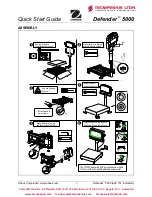
Service Manual
Page 48 of 50
<LF>xxxxxxMM<CR><LF>Shh<CR><ETX>
Name:
unrecognized command
Command:
all others
Response:
Unrecognized command
<LF>?<CR><ETX>
NOTES:
1) Weight field is always six characters (5 for weight, 1 for decimal point), regardless
of display size.
2) Leading zeroes are not suppressed.
3) High resolution weight field is seven characters (6 for weight, 1 for decimal point),
regardless of display size.
4)
If scale is outside zero range or in motion the ‘Z’ command is ignored and scale
status is returned without zero status flag set, i.e., scale not at zero.
Weight Command: W
This command causes the scale to return the displayed weight string in ECR format. The scale will usually
return the displayed weight with leading zeroes (ie no leading zero suppression).
However, if weight is negative, in motion, over capacity or under capacity, or if a zero error exists, the ECR
protocol causes only the scale's status to be returned in response to a weight ('
W
') command.
The returned weight string will include decimal point plus units of measure. The length of the weight field
will be equal to the length of the scale's display plus three (one for the decimal point, and two for the units,
e.g., "LB"). For pounds-ounce weight, the length of the weight field will be equal to the length of the scale's
display plus five (one for the decimal point, two for the "LB" and two for the "OZ"). Units of measure will
appear in their ANSI standard abbreviated form ("LB" for pounds, "KG" for kilograms, etc.) in uppercase
charact
ers.
Zero Command: Z
If zeroing criteria are met, the scale is zeroed. In any case, scale status is returned.
High-Resolution Command: H
This is the same as the
W
command except that when weight is returned, it is returned with ten times the
scale's display resolution.
Change Units Command: U
The effect of this command will be the same as if the
UNITS
key on the scale were pressed, causing the
scale to change its units of measure. In response, the scale will return the new units of measure and scale
status.
Metro Command: M
This command is optional. It will cause the scale to return normalized raw counts used for metrology
verification. The count value is the same number displayed in the scale's division test in its diagnostics
mode. For example, this number ranges up to 120,000 for the 67xx, 100,000 for the 78xx and 1,000,000
for QDT scales.
Scale Status Command: S
There will be at least two status bytes. If bit 6 of the second status byte is set then there will be a third byte.
Bit 6 of each successive byte will indicate whether or not another status byte follows. The bit will be clear
(0) in the last status byte. At this time only the first three bytes are defined. Others may be added in the
future. Bit 0 is the least significant bit in the byte while bit 7 is the most significant bit.



































